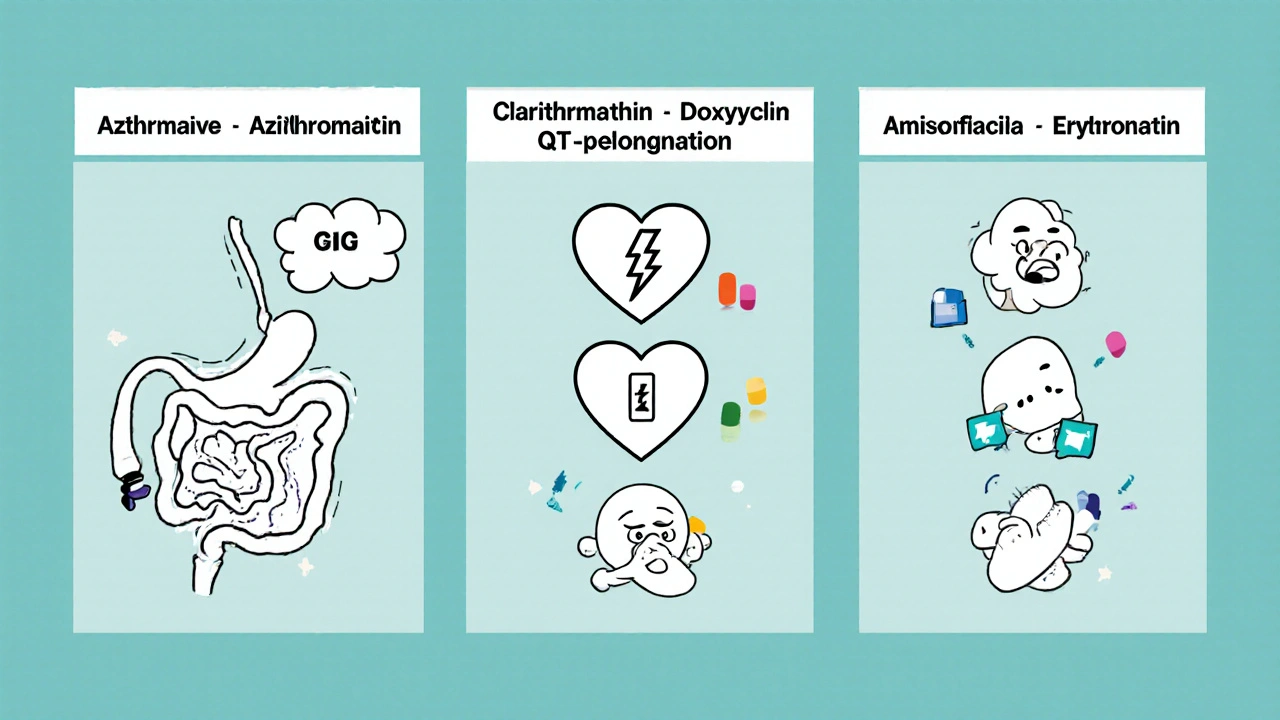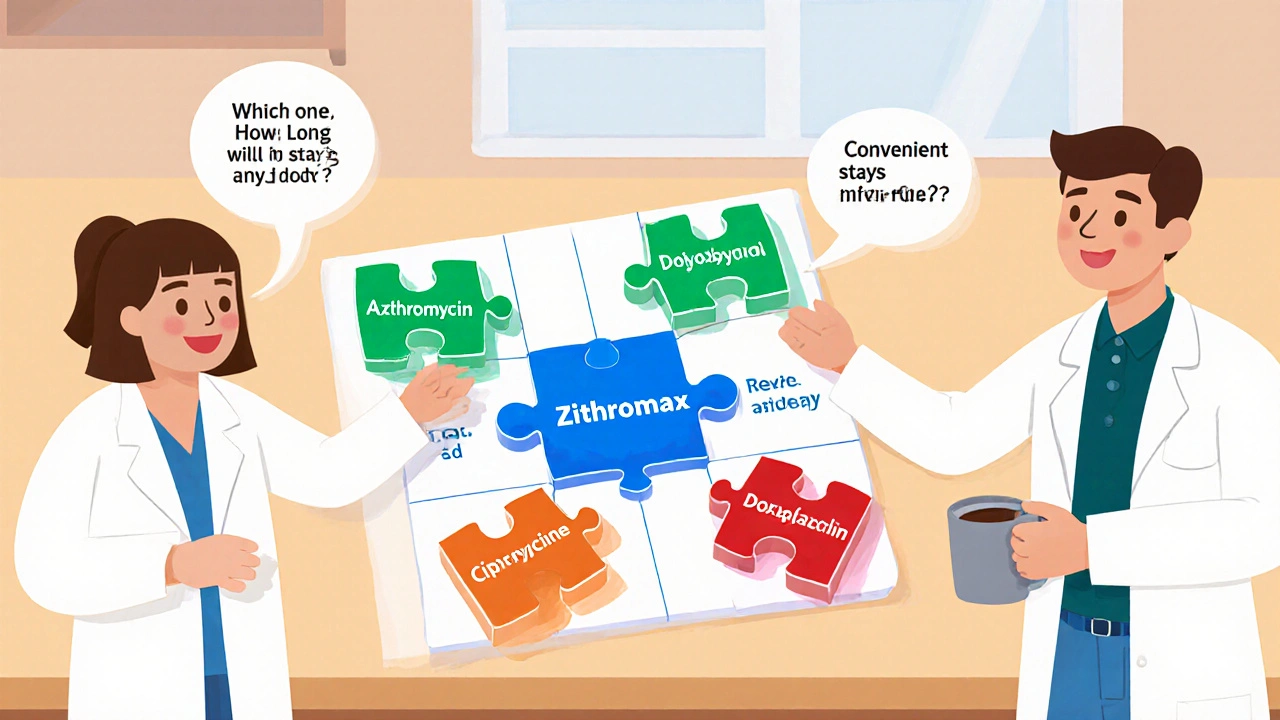Antibiotic Selection Advisor
Choosing the right antibiotic can feel like solving a puzzle-especially when you’ve heard about Zithromax but aren’t sure how it stacks up against other options. In this guide we’ll break down what makes Azithromycin unique, line‑up the most common alternatives, and help you decide which drug fits a given infection best.
What is Azithromycin (Zithromax)?
Azithromycin is a macrolide antibiotic that inhibits bacterial protein synthesis by binding to the 50S ribosomal subunit. It’s marketed under the brand name Zithromax and has been widely prescribed since its FDA approval in 1991. Its hallmark is a long half‑life-about 68 hours-so a typical course can be as short as a single dose or a three‑day regimen, which many patients love for its convenience.
How Azithromycin Works: Pharmacokinetics in Plain English
- High tissue penetration: concentrations in lung tissue can be 10‑times higher than in blood, making it ideal for respiratory infections.
- Slow elimination: the drug stays in the body for days, allowing once‑daily dosing.
- Broad‑spectrum within the macrolide class: effective against many Gram‑positive bacteria and some atypical pathogens.
These traits translate into fewer pills and better adherence, but they also shape the drug’s side‑effect profile and resistance patterns.
Top Alternatives to Azithromycin
When a prescriber says “you might need a different antibiotic,” they’re usually weighing factors like the infection type, local resistance rates, patient allergies, and cost. Below are six widely used alternatives, each with its own strengths.
- Clarithromycin is a macrolide similar to Azithromycin but with a shorter half‑life and a slightly broader coverage against Helicobacter pylori.
- Doxycycline belongs to the tetracycline class; it’s bacteriostatic, works well for tick‑borne diseases, and is cheap.
- Ciprofloxacin is a fluoroquinolone with strong Gram‑negative activity, often used for urinary tract infections.
- Levofloxacin shares fluoroquinolone traits but offers once‑daily dosing and better coverage of atypical pneumonia.
- Erythromycin is the older macrolide predecessor; it’s less convenient due to frequent dosing and more GI upset.
- Amoxicillin is a beta‑lactam antibiotic, first‑line for many common bacterial ear, nose, and throat infections.

Side‑Effect Snapshot: How They Compare
| Antibiotic | Common GI Issues | Cardiac Concerns | Allergy Rate | Resistance Trend (2024) |
|---|---|---|---|---|
| Azithromycin | Mild nausea, occasional diarrhea | QT‑prolongation (rare) | Low | Increasing in Streptococcus pneumoniae |
| Clarithromycin | Higher incidence of abdominal pain | More pronounced QT effect | Low | Stable |
| Doxycycline | Photosensitivity, esophagitis | None significant | Very low | Low |
| Ciprofloxacin | Diarrhea, risk of C. difficile | Tendinopathy, QT‑prolongation | Low | Rising in urinary isolates |
| Amoxicillin | Mild nausea | None | Moderate (penicillin allergy) | Stable |
When a patient reports heart rhythm issues, fluoroquinolones and some macrolides (including Azithromycin) need extra caution. For kids, doxycycline is generally avoided under eight years due to tooth staining.
Cost & Accessibility: What to Expect at the Pharmacy
Price often nudges the final decision. Here’s a quick snapshot (U.S. average retail, 2024 data):
- Azithromycin (Zithromax) - $15‑$25 for a full 5‑day course.
- Clarithromycin - $20‑$30 for a 7‑day pack.
- Doxycycline - $5‑$10 for a 10‑day supply.
- Ciprofloxacin - $12‑$18 for 10 tablets.
- Amoxicillin - $8‑$12 for a 10‑day regimen.
Insurance formularies frequently place Azithromycin on a preferred tier, but generic doxycycline remains the cheapest option for many infections.

Clinical Scenarios: Which Antibiotic Wins?
Below are common infections and a brief “best‑fit” recommendation based on spectrum, dosing convenience, and safety.
- Community‑acquired pneumonia: Azithromycin (single‑dose or 3‑day) or Levofloxacin if atypical coverage is crucial.
- Strep throat: Amoxicillin first‑line; Azithromycin if patient is allergic to penicillins.
- Chlamydia trachomatis: Single‑dose Azithromycin is effective, though doxycycline (7‑day) is now preferred by many guidelines for higher cure rates.
- Skin and soft‑tissue infection (MRSA‑susceptible): Clindamycin or doxycycline; Azithromycin is not reliable.
- Travel‑related diarrhea (E. coli): Ciprofloxacin (if fluoroquinolone‑susceptible) or azithromycin when resistance is high.
In each case, local resistance data-often published by state health departments-should be the final check before prescribing.
When to Avoid Azithromycin
- Known hypersensitivity to macrolides.
- Severe liver disease (azithromycin is metabolized hepatically).
- Prolonged QT interval or concurrent use of other QT‑prolonging drugs.
- Pregnant women in the first trimester-alternatives like amoxicillin are safer unless macrolide is specifically indicated.
For patients with these concerns, clarithromycin, doxycycline, or a beta‑lactam antibiotic may be the smarter pick.
Key Takeaways
- Azithromycin shines for short, convenient courses and strong lung tissue penetration.
- Alternative antibiotics fill gaps: doxycycline for tick‑borne illnesses, fluoroquinolones for resistant urinary infections, amoxicillin for classic Gram‑positive infections.
- Side‑effect and cardiac safety profiles vary; always match the drug to the patient’s medical history.
- Cost and insurance coverage can tip the scales, especially for long‑term treatments.
- Local resistance patterns are the ultimate decision‑maker-check your regional antibiogram.
Can I take Azithromycin for a viral infection?
No. Azithromycin targets bacteria, not viruses. Using it for a cold or flu won’t help and can increase resistance.
How long does Azithromycin stay in my body?
Its half‑life is about 68 hours, so measurable levels can persist for up to a week after the last dose.
Is a single dose of Zithromax enough for strep throat?
Guidelines still recommend a 10‑day course of amoxicillin for strep throat. A single azithromycin dose is only for patients who can’t take penicillins.
What should I do if I experience heart palpitations while on Azithromycin?
Stop the medication and contact your healthcare provider immediately. They may switch you to an antibiotic without QT‑prolonging risk.
Are there any drug interactions with Azithromycin I should watch for?
Yes. Azithromycin can increase levels of drugs like warfarin, statins (particularly simvastatin), and certain anti‑arrhythmics. Always tell your doctor about all meds.
When weighing options, Azithromycin often stands out for its convenient dosing. Still, the best antibiotic is the one that matches the infection, the patient’s health profile, and local resistance data. Talk with your clinician to pick the right one for you.

Octavia Clahar
October 25, 2025 AT 16:19If you’re still on the fence about Azithromycin, think about its tissue penetration – lungs get a ten‑fold boost compared to blood, which is why it’s a go‑to for pneumonia. The long half‑life means you can finish a full course in just three days, a sweet spot for busy folks. Side‑effects are generally mild, but watch out for that rare QT stretch if you have heart issues. It’s also cheap enough to sit on most formularies, so cost isn’t a huge barrier. Overall, it’s a solid choice when you need convenience without sacrificing efficacy.
eko lennon
October 26, 2025 AT 20:06When you first glance at the dosing schedule of Azithromycin, the simplicity is almost deceptive. A single 1‑gram dose or a three‑day regimen can replace a two‑week course of a more traditional antibiotic. That convenience translates into higher patient adherence, which in turn reduces the risk of sub‑therapeutic exposure and subsequent resistance. Moreover, the drug’s pharmacokinetics allow it to linger in soft tissues, delivering a sustained antibacterial punch long after the last pill disappears from the bloodstream. Clinicians often exploit this property in community‑acquired pneumonia, where rapid lung tissue accumulation is crucial. In contrast, drugs like doxycycline require twice‑daily dosing for a week or more, a regimen that many patients simply forget. The economic implications are also noteworthy, as fewer pills mean lower pharmacy costs and fewer trips to the drugstore. On the flip side, the very same long half‑life can be a double‑edged sword for those with cardiac vulnerabilities. The rare but documented QT‑prolongation events have prompted warnings for patients on other QT‑affecting meds. It’s also worth mentioning that the drug is metabolized hepatically, so severe liver disease can turn a convenient therapy into a hazardous one. Resistance patterns have shifted in recent years, with Streptococcus pneumoniae showing rising macrolide tolerance in some regions. Nonetheless, when local antibiograms still show susceptibility, Azithromycin remains a frontline option. For travelers battling enteric infections, the single‑dose simplicity can be a lifesaver in remote settings without refrigeration. Pediatric dosing, while generally safe, does require careful weight‑based calculations to avoid excess exposure. All things considered, the balance of convenience, cost, and spectrum makes Azithromycin a uniquely versatile tool in the antimicrobial arsenal.
Kala Rani
October 27, 2025 AT 23:53Most guidelines push Azithromycin for respiratory bugs but I’d say stick to amoxicillin when you can because resistance is creeping up faster than you think
Donal Hinely
October 29, 2025 AT 03:39Listen up – the macrolide crowd loves to hype up Azithromycin’s “once‑daily magic,” but you’re basically swapping one side‑effect cocktail for another, and the QT drama can turn a simple cough into a cardiac nightmare. If you’re not willing to gamble with your heart, pick a beta‑lactam or doxycycline and keep the drama to the movies.
christine badilla
October 30, 2025 AT 07:26Oh dear, you think a single dose can defeat stubborn bacteria? That’s a fairy‑tale ending you’ll regret when the infection resurfaces.
Sunita Basnet
October 31, 2025 AT 11:13Leverage the pharmacodynamic profile of azithromycin for optimal tissue distribution while minimizing dosing frequency it’s a win‑win for adherence and therapeutic index keep an eye on local MIC trends to stay ahead of resistance
Melody Barton
November 1, 2025 AT 14:59Choosing the right drug can feel overwhelming but remember the key is matching the infection type to the antibiotic’s strengths. Azithromycin works great for lungs, doxycycline shines for ticks.
Justin Scherer
November 2, 2025 AT 18:46When evaluating options, consider spectrum, side‑effect profile, and local resistance data to make an evidence‑based decision.
Pamela Clark
November 3, 2025 AT 22:33Sure, because nothing says “smart medical choice” like picking the most expensive pill for a simple sore throat.
Diane Holding
November 5, 2025 AT 02:19Azithromycin’s convenience is its biggest selling point.
Cheyanne Moxley
November 6, 2025 AT 06:06It’s irresponsible to prescribe a broad‑spectrum antibiotic when a narrow‑spectrum agent would do the job; overuse fuels the superbug crisis and puts future patients at risk.
Kevin Stratton
November 7, 2025 AT 09:53We chase the perfect cure but medicine is a balance of art and science – sometimes the simplest regimen is the most profound :)